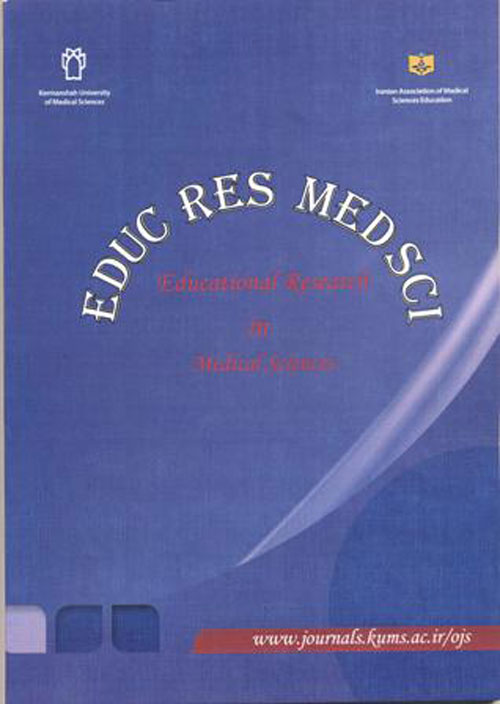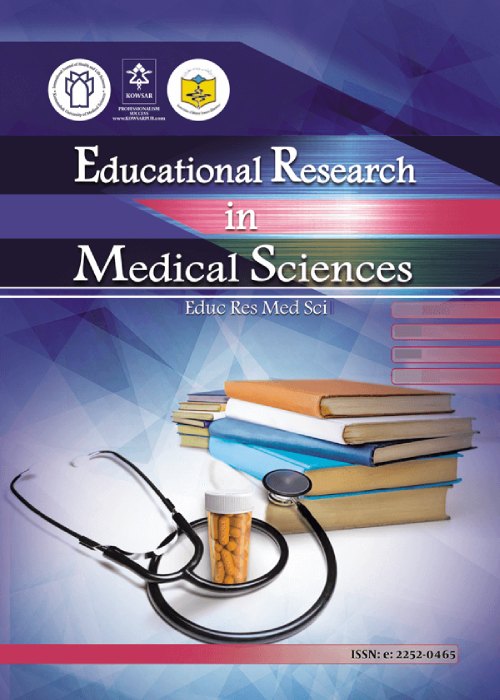فهرست مطالب

Educational Research in Medical Sciences
Volume:5 Issue: 2, Dec 2016
- تاریخ انتشار: 1395/10/28
- تعداد عناوین: 8
-
-
Pages 52-56IntroductionEvidence-based education has been introduced to dentistry as a new educational tool. However, its effectiveness should be evaluated in different educational topics. The aim of this study was to compare the effects of evidence-based and conventional education on radiography assessment before endodontic treatment.MethodsIn this semi-experimental study 75 senior dental students of Kermanshah Dentistry School were enrolled. Demographic information and the results of evaluation were collected using a weblog designed for this purpose. 20 questions were prepared to be answered in 30 minutes. 12 topics were covered in the questionnaire. To analyze the data, the paired sample t-test, Wilcoxon, and Whitney U tests were used.ResultsThe finding of the present study showed that total scores of the test in both conventional and evidence-based groups significantly improved after education (P=0.005 and P=0.001, respectively). There was a significant difference between the two groups (P=0.047) and evidence-based education showed better results in comparison with conventional one.ConclusionThe present study asserts that evidence-based education can lead to better diagnostic performance of senior dental students and thus can be used as an efficient alternative for conventional education methods in dental schools.Keywords: Evidence, based, Education, Dental students, Endodontic, Treatment
-
Pages 57-63IntroductionIt is assumed that working memory plays a pivotal role in carrying out all sorts of cognitive functions. The introduction of working memory software has provided researchers with an asset to investigate the differences among individuals which can be attributable to differences in working memory capacity. Following the advent of working memory software, there were also other pieces of software available to the public with the prospect of helping individuals enhance their working memory capacity and as a result enjoy any possible benefits. This study aimed at investigating the possible effects of working memory improvement on some university students reading comprehension in English.Methods30 adult university students chosen through convenience sampling approach participated in this study. They were randomly divided into an experimental and a control group. Both groups took pretest on their reading comprehension using three reading texts in English and working memory capacity carried out via the Working Memory Software. While the control group took posttests on the same tests after five weeks, the experimental group underwent a working memory training program consisting of ten sessions before taking the posttests.ResultsThe results of t-test analysis showed a significant statistical difference in the performance of the two groups on the working memory test, but their reading task performance scores did not show a significant difference.ConclusionThe working memory training program did not seem to benefit the participants in carrying out reading comprehension in English.Keywords: Memory training, Reading, Comprehension, Language training, Students
-
Pages 64-73IntroductionThe strategic plans of nursing are in line with training the nurses that are able to make positive changes in the caring environment and to improve the life quality of individuals, families, and community. Each country has different methods of nursing education, which are rooted in its customs and traditions. Comparing different educational systems promotes the content and quality of the curriculum. This study performed a comparative study of nursing education in Iran and George Washington University.MethodsThis comparative study was conducted in 2016 to compare the constituents of Bachelor of Science in Nursing (BSN) program in Iran and George Washington University in the United States. The Beredy model was used to compare the collected data, which encompasses description, interpretation, juxtaposition, and comparison.ResultsAlthough nursing education in Iran is mostly influenced by education models in the United States, the two countries have major differences in their nursing education system. BSN in Iran is a four-year program and has a semester system. The students are selected from among the candidates of experimental sciences through a nationwide university entrance examination. In all universities across Iran, one curriculum is presented, and there is limited flexibility in the program due to environmental conditions, while BSN in the United States has a two-year program, and student admission regulations are formulated independently by each university. The number of compulsory units is 130 units in Iran and 180 units in the United States.ConclusionThe nursing curricula in Iran and George Washington University have differences and similarities. Thus, considering the cultural, social, historical and economic differences, comparing them can be helpful to solve the problems and challenges in nursing education.Keywords: Comparative study, Nursing education, Statistical model
-
Pages 74-80IntroductionThis study was conducted to evaluate the association of dimensions of an efficient teacher with entrepreneurial motivation from the viewpoint of students.MethodsThe study population of this research included 110 pharmacy students (above third semester) at Kermanshah University of Medical Sciences, among whom 86 students were selected as the study sample through simple random sampling using Cochrane formula. The effective teacher questionnaire (researcher-made), with Cronbach's alpha of 0.95, and the entrepreneurial motivation scale, with Cronbach's alpha of 0.81, were used to collect the data. The collected data were analyzed by SPSS.21 software using correlation coefficient and simple linear and simultaneous regression analysis.ResultsThe results showed a significantly positive correlation between personality traits from among the dimensions of effective teacher and student's entrepreneurial motivation (PConclusionThe personality traits of an effective teacher can significantly explain entrepreneurial motivation. Thus, personality traits are the most essential factors to be used to achieve educational objectives and to inspire entrepreneurial motivation.Keywords: Entrepr eneurship, Motiv ation, Education, Students
-
Pages 81-86IntroductionSatisfaction of the students as educational institutions customers plays a major role in the performance and activities of the university. The aim of this study was to evaluate the degree of satisfaction of pharmacy students and their educational status in Kermanshah University of Medical Sciences in the year 2014.Methods48 pharmacy students at 9th to 11th semesters participated in this cross-sectional study. The student's satisfaction was evaluated in 14 different domains. Various fields related to basic and specialized training, educational space, communications, group's performance, facilities and teaching space were investigated. Data were collected using a questionnaire whose validity was confirmed by experts, and its reliability has already been proven by Cronbach's alpha test. For comparing scores between bimodal variables, Mann-Whitney U test was used, and for comparisons between multimodal variables, Kruskal-Wallis test was used. The collected data were coded and analyzed using the statistical software SPSS.17.ResultsThe moderate students satisfaction with the entire fields was 70.8%, with women's satisfaction more than mens. Student's satisfaction with the effectiveness of the education system and whether training is to increase the professional capabilities was 82.9%. Average student's satisfaction with the facilities such as laboratories, library and electronic sources was 77.1%.ConclusionThe overall satisfaction of pharmacy students with the School of Pharmacy was assessed as moderate. Thus, doing some actions to increase the level of satisfaction is necessary.Keywords: Satisfaction, Students, Pharmacy, Education al status
-
Pages 87-96IntroductionIdentifying service recipients perceptions and evaluating service quality are the basic steps toward compiling quality assurance programs. In this regard, the present study aimed to determine the quality of educational services using service quality (SERVQUAL) model and from students viewpoint.MethodsA cross-sectional study was conducted on 176 Iranian students of Alborz University of Medical Sciences in 2014 who were selected trough stratified random sampling. Student's perceptions and expectations of educational service quality were measured through a questionnaire that was designed according to SERVQUAL approach based on five dimensions of assurance, responsiveness, empathy, reliability and tangibles. Data was analyzed by the SPSS 21 software through paired-sample t-test and one-way ANOVA statistical tests.ResultsThe results revealed that, in all five dimensions of SERVQUAL, students expectations were higher than their perceptions and there was a significant quality gap between their perceived and expected educational services provision. The highest and the lowest quality gaps belonged to the tangibility (1.16) and reliability (1.03) dimensions, respectively. Moreover, The empathys sub-dimensions of "exterior attractiveness of physical facilities like buildings, classrooms, chairs, and restrooms" and "respectful behavior of teachers toward students" showed the highest )-1.93) and the lowest (-0.80) quality gaps, respectively. Also, the results showed that there was a significant difference between the mean scores of different majors in all aspects of service quality and significant differences in empathy, reliability and tangibles dimensions between the different academic degrees (PConclusionAccording to the results, the quality of current services provided by this public university was not meeting the expectations of students particularly in case of physical space of faculties. Thus, it is recommended to provide and deliver services based on students needs and expectations.Keywords: Education, Quality assurance, Student, SERVQUAL model
-
Pages 97-102IntroductionClinical education is a dynamic process in which- students, with presence in bedside, gain experience and interact with the teachers and the environment to apply learned concepts in practice. If the education fails to provide appropriate learning conditions, would be no possibility for clinical skills to nurture. This study was performed to determine the satisfaction of medical interns with the quality of clinical education in Rasht teaching hospitals in 2014-15.MethodsThis descriptive-analytical study was carried out on 106 medical interns of Guilan University of Medical Sciences in 2014-15 using convenience sampling. The data were collected by a validated researcher-made questionnaire consisting of 3 sections and 39 items. SPSS.21 and descriptive and inferential statistics (Chi-square test, Fisher's exact test, and Man-Whitney U test), considering 95% confidence interval and 90% test power, were employed to analyze the data.ResultsThe results showed that 50% of the interns were highly satisfied with the quality of education and the mean-score of students satisfaction was 65.68±14.19 out of 102. The interns satisfaction rate of different components was: familiarity with the objectives of the course (32.1%), teaching methods (53.8%), evaluation methods (41.5%), facilities and equipment (46.2%), students clinical skills (24.5%), and teachers skills (51.2%). There was no significant relationship between satisfaction and demographic factors (P>0.05).ConclusionGiven the fact that the students were not highly satisfied with some of the components of clinical education such as familiarity with the objectives of the course and students clinical skills, it is recommended that the educational planners pay more attention to these components.Keywords: Satisfaction, Clinical, Education, Medical students
-
Pages 103-106Medical students as future doctors play an important role in society health promotion. This study aimed to assess medical student's attitude to their field at Qom University of Medical Sciences (2015). Participants in this cross-sectional study included all three-year pre-clinical stage medical students. 145 students completed Minnesota University standard questionnaire. Scoring of the questionnaire is based on Likert scale. Scores between 16 and 80 represent the total possible score achieved. Data were analyzed using t-test, ANOVA and Pearson correlation coefficient. Mean and standard deviation of the student's attitude score was 59.31±6.68. 11%, 67.6%, 20.7%, and 0.7% had optimistic, good, moderate, and poor attitude, respectively. The mean score of attitude did not have a significant difference in terms of gender, marital status, and status of residence (P>0.05). Having a positive attitude towards one's discipline and future career plays a critical role in learning activities. Appropriate attitude need to be considered in medical education.Keywords: Students, Medical, Attitude, Employment


